Yesterday saw the surprise release of Angélus 2018, catching much of the trade off guard. Last year the first major release was Palmer 2017, which came nine days later on 25th April. The year before that, early bird Cos d’Estournel released its 2016 on 24th April.
Angélus 2018 is being offered in the UK at £255 per bottle (£1,530 per case of 6), and in Europe at €295 per bottle. This is 9% below its 2017 price, and equivalent to its 2015 en primeur release price. This makes the wine available at a small discount to the 2009, 2010, and 2016 vintages. However, 2014 and 2015 are physically available in the market for less.
Being the first out of the blocks gives Angélus an advantage: not only does it have the trade’s full attention now, but it also has a long stretch ahead for the wine to sell, and its discount on 2017 may end up looking attractive if others don’t follow suit.
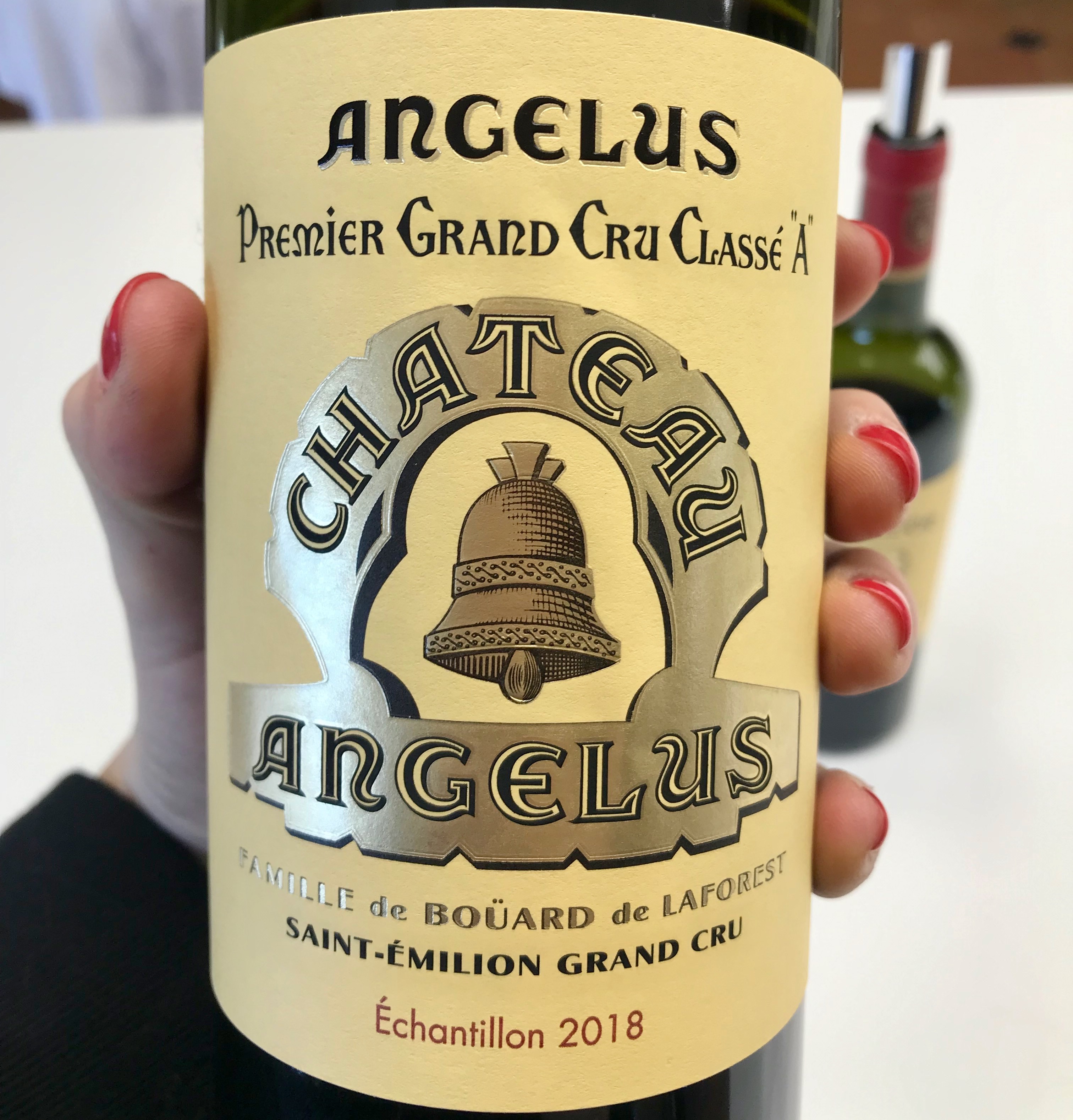
None of Wine Lister’s partner critics has rated the wine yet. We tasted it 10 days ago at the château and found it delightfully fresh, precise, and crystalline, in a more restrained and elevated style than in the past, but still with impressive density. It is an excellent wine, and needs to be at this price.
After years of price repositioning since its promotion to premier grand cru classé A in 2012, Angélus was smart in making this step to “correct” its price (and arguably it could have gone further).
Nonetheless, the gesture seems to have been appreciated by the market, whose hope is that this will start a trend for the upcoming campaign, of châteaux decreasing on last year’s release price. Only time will tell whether others follow suit, or if this is a mere anomaly.
Ella Lister
April 17, 2019
In June 2018, the idea that Bordeaux had a very good vintage on its hands was laughable. The first half of the year had seen incessant rain in the region. Mildew was rife and vignerons were fighting it all day long, including at weekends (if they could afford to). At Château Corbin, owner Anabelle Cruse cancelled her trip to Vinexpo Hong Kong to be on site to manage treatments. “We couldn’t afford any mistakes after losing nearly all of the 2017 vintage [to frost],” she said.
But then on 18th June, the weather turned, and barely another drop of rain fell until September. 2018 was a year of extremes for Bordeaux. “It started hellish, and finished in ecstasy,” said Sara Lecompte Cuvelier, Managing Director at Léoville-Poyferré. “It started a nightmare and finished a dream,” echoed Guillaume Pouthier, Director at Carmes Haut-Brion.
Against all odds, some truly extraordinary wines were made. “Technically, it’s the most accomplished wine we have made since I joined,” said Nicolas Glumineau, Managing Director of Pichon Comtesse since 2012. Adrien Bernard declared, “the 2018 [red] is the greatest wine my dad has made” – the Bernard family bought Domaine de Chevalier in 1983. But 2018 was not a great vintage across the board like 1982, 1989, or 2010. It wasn’t a vintage where you could make a great wine with your eyes closed. On the contrary, 2018 is a vintage where human choices really mattered, and at the top level, happily, these choices were usually the right ones.
 Happy with their 2018s: Guillaume Pouthier, Pierre-Olivier Clouet, and Nicolas Glumineau
Happy with their 2018s: Guillaume Pouthier, Pierre-Olivier Clouet, and Nicolas Glumineau
Concentration in the 2018s is at unprecedented levels: grapes were lost to mildew in the spring, and then the summer drought left remaining berries very small, without much juice. Picking dates were key: the temptation to leave the grapes hanging in the Indian summer was strong, but success in 2018 was all about retaining freshness to counter the high levels of alcohol and tannin.
Even those who picked early were still facing unknown territory. Many producers recounted the topsy turvy ratio of marc to juice in the vats (more skins and pips than liquid). As a result, tannin levels were off the scale, with IPTs (Indice de Polyphénols Totaux) at their highest ever recorded for many producers. At Lynch-Bages, Technical Director Nicolas Labenne explained that, “a normal IPT would be 70, a good year is 80, and we’re at 95 in 2018.”
“But it’s the quality of the tannins that’s important,” Pouthier reminded us. This colossal potential needed taming by the winemakers if they were to make gentle giants, and not monsters in 2018. “This was a year where you couldn’t go into the cellar and say, ‘well every year I do it like this so I’ll do the same’,” said Lillian Barton. “You had to be careful with the extraction,” she explained.
During our tastings last week, producers of the best wines explained their use of more gentle, less frequent extraction, and vinification at lower temperatures than normal. At Petrus, winemaker Olivier Berrouet explained that, “In a hot vintage it’s tempting to go further, but we wanted to keep delicacy; we let the wine infuse like tea.” He was not the only one to talk about “infusion”, some châteaux foregoing altogether the use of extraction techniques such as pumping over and punching down. This allowed subtler winemakers to achieve silky, creamy tannins that melt in the mouth, while retaining all the generous flavours from the uniquely concentrated grapes.
The 2018 vintage really is one of a kind. “It’s impossible to compare it to another vintage other than to say 2016 plus plus,” offered Pierre Graffeuille, Managing Director at Léoville Las Cases, because it has “more of everything.” More alcohol, more tannin, more flavour, but also in the best examples (and there are many), more freshness and more silkiness (some of which have been highlighted in Wine Lister’s 2018 tasting favourites). So if you believe that more is more, this is a vintage for you. Just beware that some wines have all the beast and none of the beauty.
In part II of this en primeur round-up we will look at production volumes before considering the upcoming campaign – its context, as well as likely timing and pricing. Watch this space.
Part I of our annual Bordeaux study is available here, and part II will be released to subscribers in May. Follow us on Twitter for the 2018 Bordeaux en primeur release updates, or for real-time analysis enquire here about subscription to Wine Lister Pro.
Last week, members of the Wine Lister team were in Bordeaux tasting hundreds of Bordeaux 2018s en primeur. Our full report of the 2018 vintage (similar to last year’s article on 2017) will be out soon, and in the meantime we examine below some 2018 tasting highlights.
Quality across the wines we tasted is extremely high. We have selected 42 highlights, including 10 underdogs – those wines we felt surpassed our quality expectations.
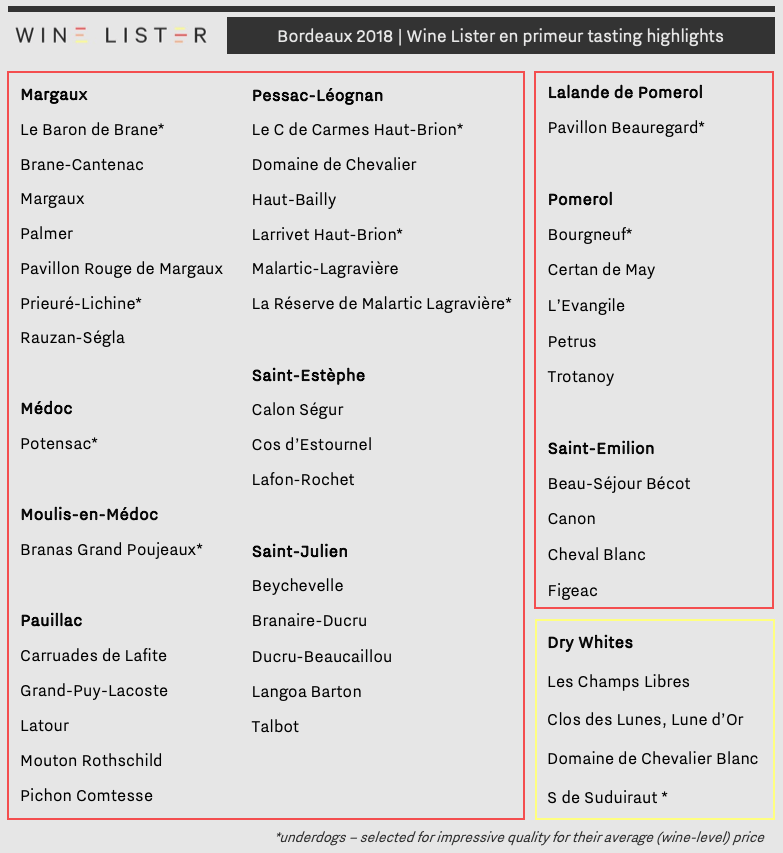
The Wine Lister team found beautiful wines in all the left bank appellations. Margaux and Pessac-Léognan appeared the most consistent for high quality, earning seven and six highlights respectively. These two appellations are home to five of Wine Lister’s 10 underdogs of 2018 en primeur tastings.
The former includes its first-growth namesake, Château Margaux, which was precise, addictive, and harmonious. Pavillon Rouge de Margaux also made the cut thanks to its intriguing and soft fruit character. Brane-Cantenac is becoming a Wine Lister staple after appearing in both 2016 and 2009 tasting highlights. Its 2018 was pure, fresh, and a perfect balance between power and finesse.
In Pessac-Léognan, Domaine de Chevalier had piercing intensity balanced with a floral softness, while Haut-Bailly impressed with a playful fruit character and velvet texture.
Elsewhere on the left bank, Branas Grand Poujeaux surprised with its classy, energetic, dark fruit. Pauillac produced examples of intense fruit handled with a delicate touch (Grand-Puy-Lacoste and Pichon Comtesse). Saint-Estèphe presented beguiling wines with great freshness and elegance (Cos d’Estournel). Saint-Julien showed depth of flavour and complexity in equal measure (Langoa Barton, Ducru-Beaucaillou).
The right bank was just as impressive, with an equal proportion of highlights for Wine Lister as the left (in each case, 19% of wines tasted made the cut). These include one underdog (and new discovery for Wine Lister) from Lalande de Pomerol, five stand-outs from Pomerol, and four from Saint-Émilion.
In Pomerol, Petrus was alluring, generous, and floral, while Trotanoy had delicate strength and never-ending energy. Saint-Émilion produced favourites of varying styles, including Cheval Blanc – a magical, mesmerising boudoir-style wine, and Canon – dancing, racy, and fresh.
Readers should note that these 42 wines are some of the team’s favourites from last week’s tastings, but that we will be releasing official Wine Lister Buys throughout the campaign as prices become known. WL Buys take into account a wine’s quality (based on our partner critics’ scores, which we look forward to adding as soon as they are released), and value within the vintage and appellation, as well as Wine Lister’s personal opinion based on our own tastings and market insights.
Trade members wishing to gain full access to Wine Lister’s en primeur campaign coverage will need to subscribe to Wine Lister Pro. Register your interest here.
As July begins, much of the wine world may feel more grey and drizzly than the weather would suggest, due to a case of post-primeurs blues. Indeed, Wine Lister’s founder, Ella Lister, reports in her recent article for JancisRobinson.com that “…the majority of merchants are reporting revenues down approximately two-thirds on 2016”. In that article, a comparison of Quality scores across recent vintages highlights the value proposition of the 2014 vintage. In this blog post we dig a bit deeper.
A few weeks into this year’s en primeur campaign releases, the Wine Lister team noticed a distinct pattern. With almost every new release, we sounded more and more like broken records, echoing that château X’s 2017 release price, while below the last two vintages, made the 2014 look like good value. While it has been pigeonholed as a good but not great vintage, 2014 achieved consistently high critics’ scores that imply its reputation should be better.
The chart below shows Bordeaux 2014 and 2017 average Quality scores by appellation, comparing 2014 three-month average prices with 2017 release prices.
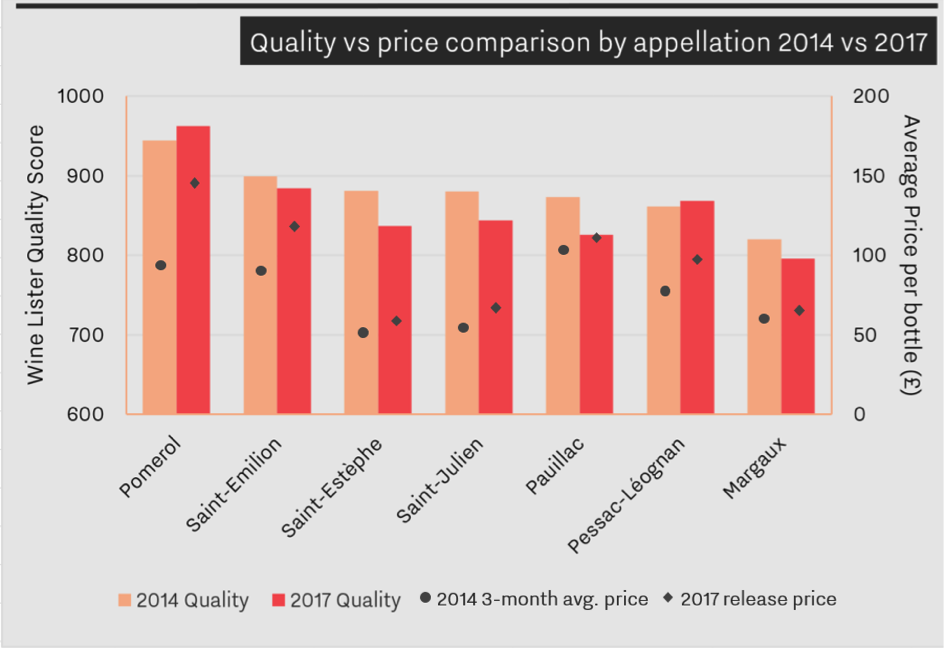
Based on 75 key Bordeaux classified growths, the chart illustrates the relationship between quality and price (note the price gap for 2014 and 2017 Saint-Émilion, despite similar average Quality scores). Only Pomerol and Pessac-Léognan achieved higher Quality scores on average in 2017 than in 2014, with Wine Lister’s partner critics preferring 2014 across all other appellations.
While the trade puts aside its allocations of 2017 for the time being, perhaps the silver lining is the light this vintage shines on relative value elsewhere. Is it time for merchants and collectors alike to focus on 2014?

We used Wine Lister’s comparison tool in our search for good-value back vintages in order to compare different vintages and their respective critics’ scores and prices. For example, Malescot Saint-Exupéry achieves a Quality score of 894 in 2014, versus 735 in 2017. Despite the substantial price reduction on the 2016 and 2015 vintages, the 2017 UK market price remains 5% higher than the 2014, the latter receiving higher scores from three of the four Wine Lister partner critics. Neal Martin disagrees, awarding the 2017 a potential 2 points more than 2014 saying, “it is not a complex Malescot St. Exupéry, but I admire the balance and focus”.
Malescot Saint-Exupéry 2014 has the highest Value Pick score of any recent vintage:
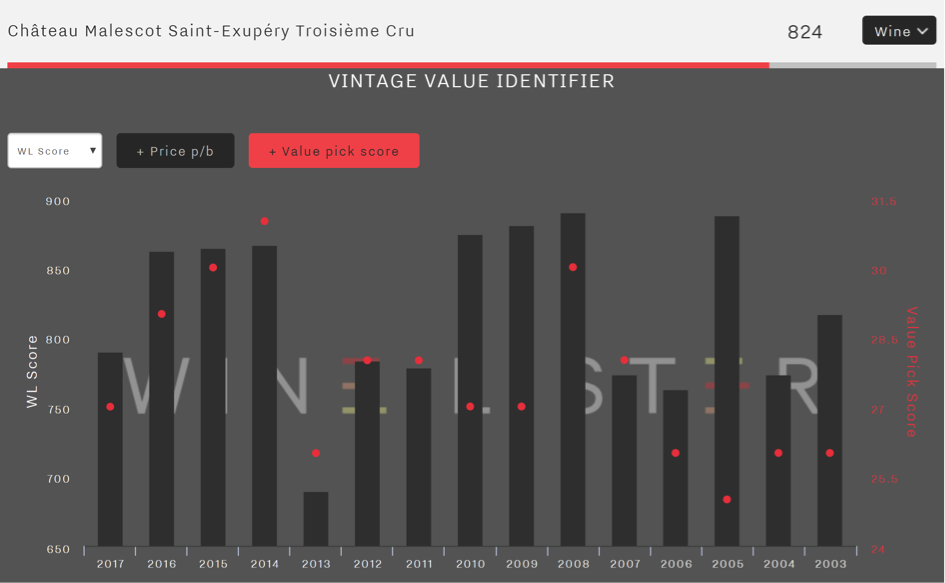
Use the Vintage Value Identifier chart (pictured above) on every wine page to pick out the best value back vintages. For example, Cantenac-Brown’s 2014 looks like a particularly good buy, at £25.50 per bottle for the 2014 (whose Quality score is 800), versus the 2017 at £34.05 per bottle, with a Quality score of 715. Its 2015 looks good too.
As a sort of postscript to the difficult 2017 en primeur campaign (read our CEO Ella’s thoughts here), over the past week or so Pomerol powerhouses Petrus and Le Pin were released at £1,480 and £1,750 per bottle respectively. With Pomerol wines achieving the top three Quality scores of all reds for 2017 – and five of the top 10 – it was the top-performing red appellation of the vintage.
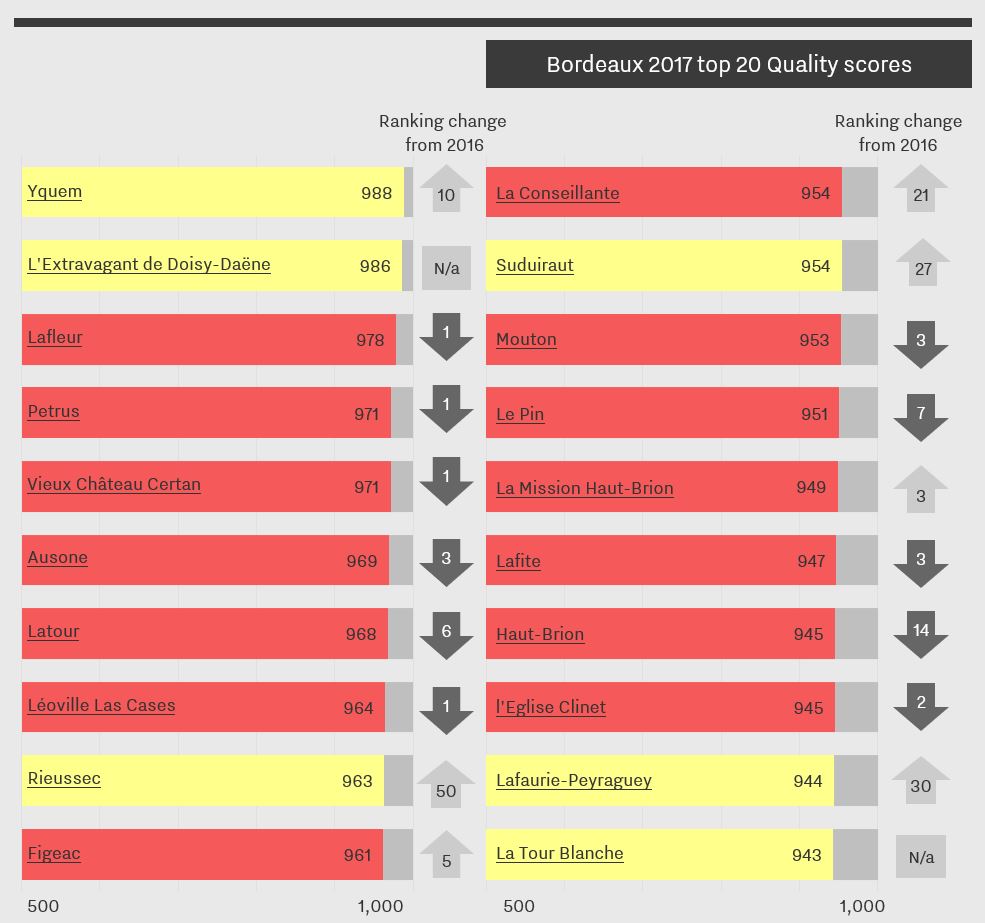
Now that we have release prices for all of Pomerol’s top wines, we can see which came out on top in terms of overall Wine Lister score*.
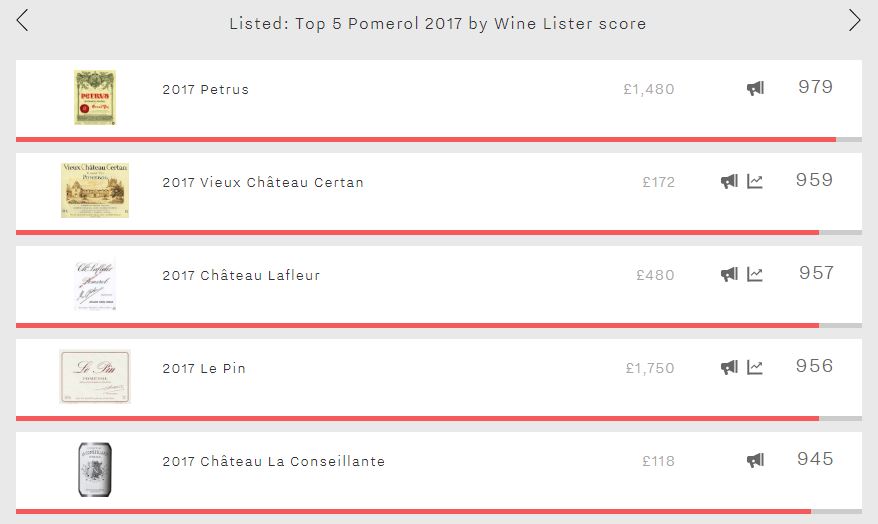
With a score of 979, Petrus was not just Pomerol’s leading wine of 2017, but the number one wine in Bordeaux. This is perhaps unsurprising given that it received the joint-second best Quality score of the vintage of all reds (971) – alongside Vieux Château Certan – and also has a Brand score of 998 (beaten only by Lafite, Latour, Mouton, Yquem, and Dom Pérignon Vintage Brut) along with a wine-level Economics score of 978 (third-best in Bordeaux). With Wine Lister’s Founding Members voting it the second-most prestigious wine in the world in a recent survey, behind DRC La Romanée-Conti, Petrus is currently unbeatable in Bordeaux.
Number two on the 2017 Pomerol leaderboard is Vieux Château Certan (959). While the confidence rating attributed by Wine Lister’s Founding Members slipped a point over the past year from 9/10 to 8/10, it nevertheless achieves Pomerol’s second-best Brand score (972). Thus, despite its relatively modest Economics score (909) – still putting it amongst the very best on Wine Lister’s 1,000 point scale – the 2017, thanks to its excellent Quality score, manages to edge just ahead of Lafleur in terms of overall Wine Lister score (957).
Lafleur 2017, the best red wine of the vintage for Quality (978), was released in early May at £430 per bottle, a 7% decrease on the 2016 release price. This was Neal Martin’s favourite of the five, Wine Lister’s newest partner critic awarding it a score of 95-97 /100 and commenting: “This is an awesome 2017 from Baptiste Guinaudeau, one of the few that will oblige several years in the cellar”.
Le Pin 2017 was released in the UK at £1,750 per bottle, its 25% decrease on the 2016 release price the largest year-on-year reduction of the five. It experiences the lowest Quality score of the five for the vintage (951), and also has the group’s lowest Brand score (944). The fact that the 2017 betters Lafleur and La Conseillante in terms of overall Wine Lister score is thus the result of its formidable Economics score (980), which it achieves not just because of its high average price but also strong growth rates, which are the best of the group over both the long and short-term.
Rounding out the group is La Conseillante (945). Whilst it is by far the most affordable of the group, it is the only one of the five whose 2017 climbed the Bordeaux Quality score table compared to 2016, surging 21 spots to be the eighth best red and 11th best overall.
Remember that you can catch up on all of the campaign’s releases on our dedicated en primeur page.
* Please note that overall Wine Lister scores for en primeur wines use estimated Economics scores based on the performance of back vintages.
Petrus 2017 was released in the UK at £1480 per bottle (19% down on 2016), with a lower Quality score: 971 (vs 991).
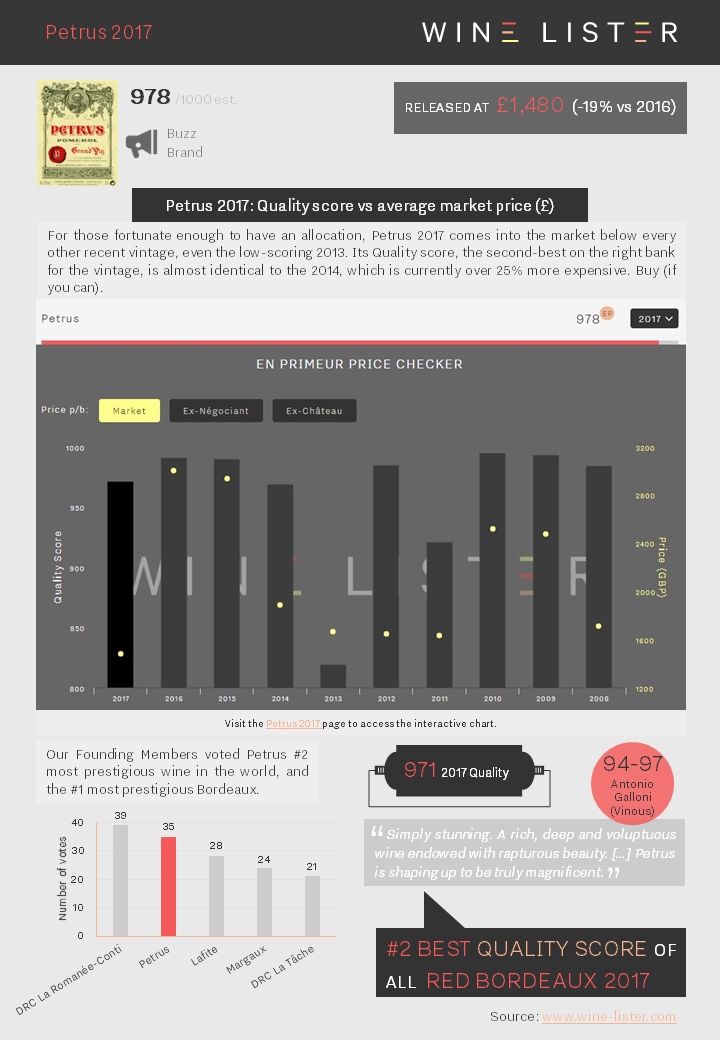
You can download the slide here: Wine Lister Factsheet Petrus 2017
Ausone 2017 released at €400 ex-château (18% down on 2016), which will likely result in a UK release price of c.£492 (also 18% down on 2016), with a lower Quality score: 969 (vs 987).
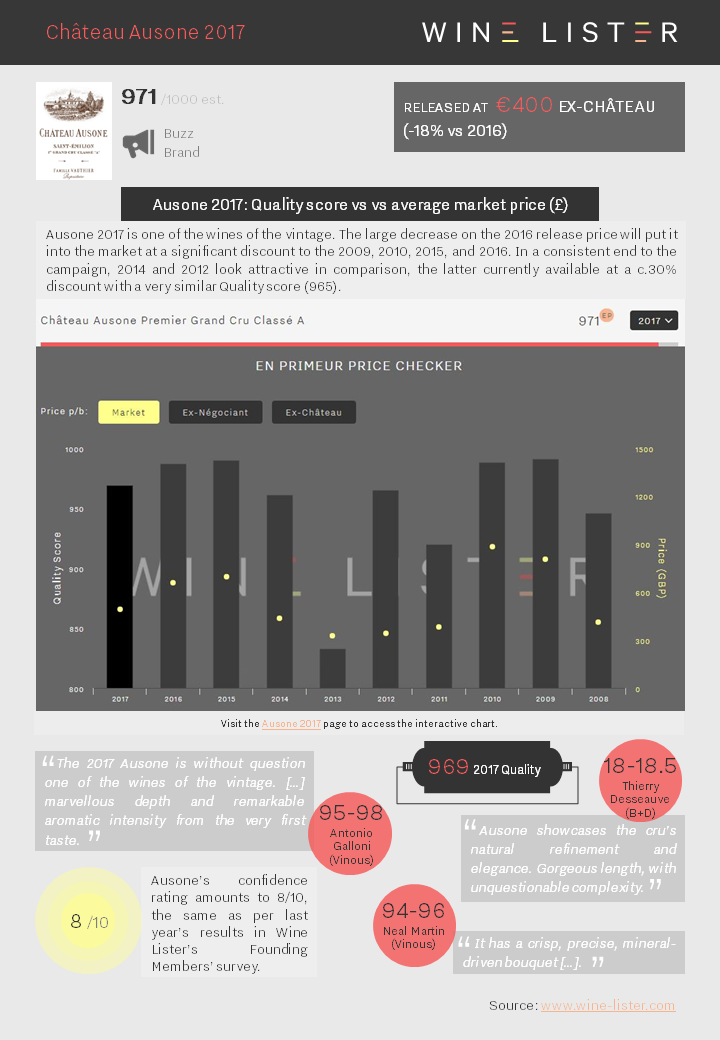
You can download the slide here: Wine Lister Factsheet Ausone 2017
Cheval Blanc 2017 released at €432 ex-négociant (22% down on 2016), with a UK release price of £442 (17% down on 2016), and a lower Quality score: 938 (vs 989).
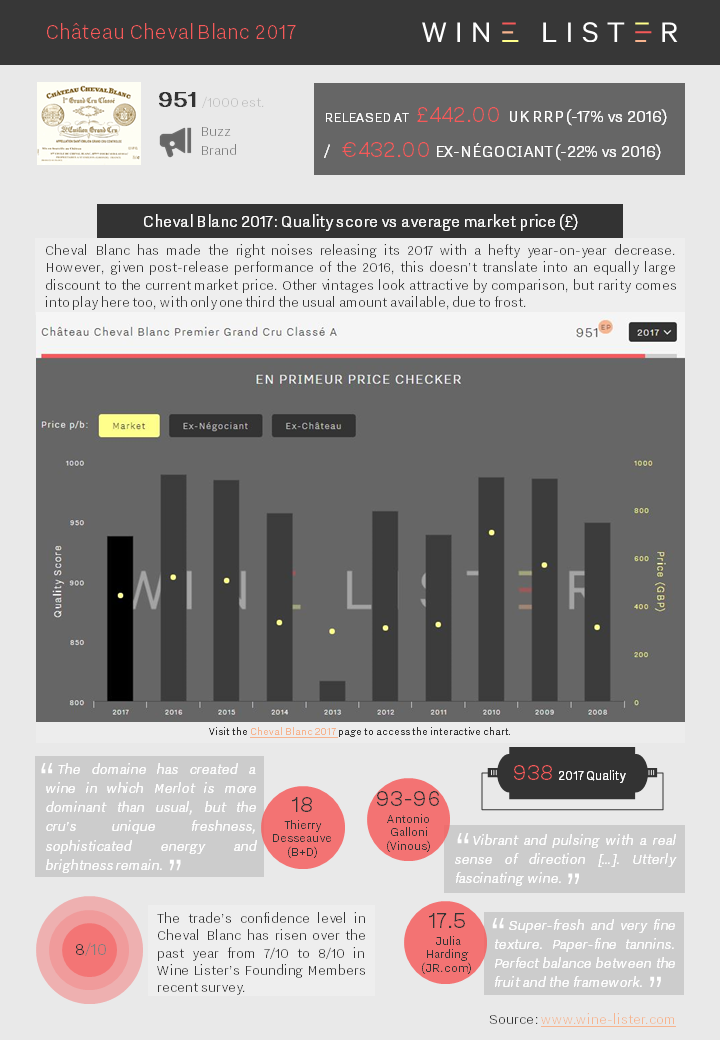
You can download the slide here: Wine Lister Factsheet Cheval Blanc 2017
Vieux Château Certan 2017 released at €168 ex-négociant (13% down on 2016), with a UK release price of £172 (also 13% down on 2016), and a lower Quality score: 971 (vs 991).
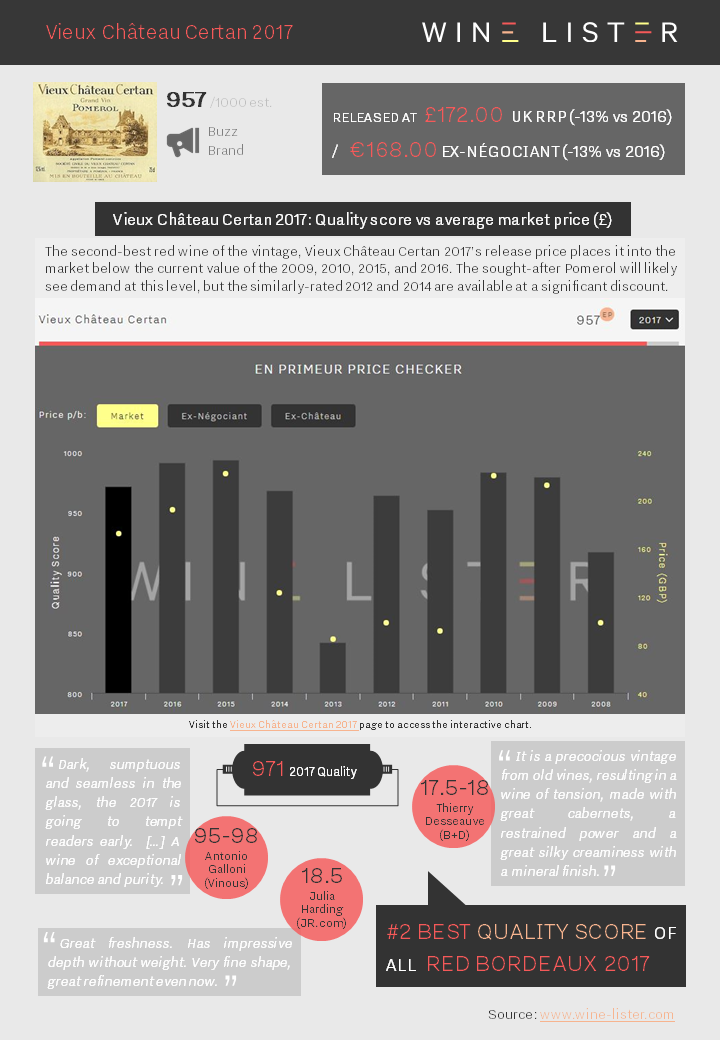
You can download the slide here: Wine Lister Factsheet Vieux Château Certan 2017
Lafite 2017 released at €350 ex-château (8% down on 2016), and is being offered in the UK at £415 (15% down on 2016), with a lower Quality score: 947 (vs 987).
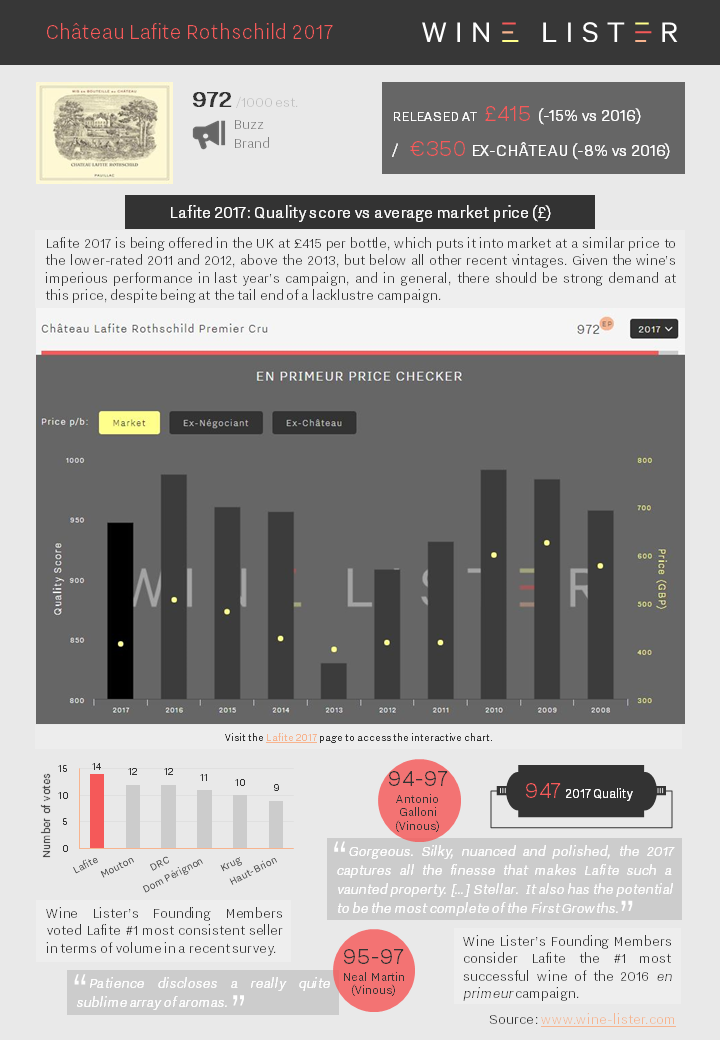
You can download the slide here: Wine Lister Factsheet Lafite Rothschild 2017

 Happy with their 2018s: Guillaume Pouthier, Pierre-Olivier Clouet, and Nicolas Glumineau
Happy with their 2018s: Guillaume Pouthier, Pierre-Olivier Clouet, and Nicolas Glumineau









